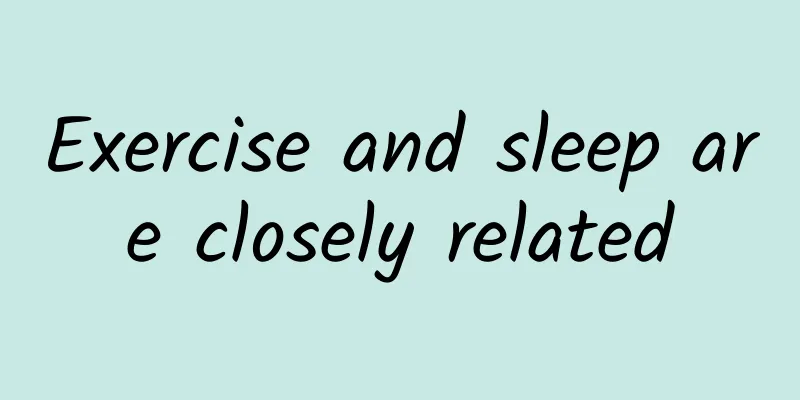Exercise and sleep are closely related

|
The pressure of further studies, performance, and retirement, as well as the fast-paced social life, force those of us who want to achieve something to temporarily sacrifice some things that seem less important, such as sleep. “I haven’t had a good night’s sleep in a long time.” “I worked all night to finish the project” "I had so many dreams last night, it was like I didn't sleep at all" "I stayed awake till dawn for a week straight"... "Poor sleep" seems to have become the norm in our lives. Over the years, the possibility of developing chronic insomnia is increasing. Have you ever worried that when you need "it" again, it will be difficult to find it again? We need to learn to prevent problems and adjust ourselves! Exercise, which seems somewhat "childish" and "insignificant" among the various methods of insomnia treatment, is indeed a significant means of self-regulation. Whether it is maintaining emotional stability, increasing sleep drive, or regulating the regularity of the biological clock, it has its unique features and deserves our attention and utilization. 01How does exercise help you sleep? Shakespeare once likened sleep to "Nature's nanny" because adequate sleep makes people energetic and radiant, is the lubricant of the body's life activities, and can help the body's neuroendocrine functions achieve coordination and balance. There are many factors that affect sleep quality, and the following factor is particularly critical. Research shows that human body temperature changes in a very regular way: starting at 6 a.m., your body temperature will continue to rise until 12 p.m., when it will experience its first slight drop, and then rise again, reaching its highest point of the day at 9 p.m. After the peak, the body temperature begins to drop, reaching its lowest point at about 4 a.m., every day. Although the maximum temperature difference can reach 2°, it will always fluctuate around 37°. We call the regular rise and fall of body temperature "body temperature rhythm". Body temperature rhythm can effectively guide the brain to accurately switch states and is a very important sleep regulator. Under normal circumstances, when the body temperature rises, people tend to be more awake; when the body temperature drops, people will feel sleepy and tired. Based on this, we found that there is a way to help us use body temperature changes more effectively to improve sleep quality, and it is "exercise". Take aerobic exercise as an example. Aerobic exercise can significantly increase your body temperature, making the peak temperature at a higher level and delaying the temperature drop, which will help us stay energetic, more awake and energetic during the day. On the other hand, aerobic exercise can also continue to prevent the body temperature rhythm curve from flattening. When the body temperature drops, its lowest value will be lower than before, making you feel more sleepy after exercise and easier to fall asleep. And this is the magic of exercise to help sleep~ 02 Exercise precautions Does that mean that as long as I go downstairs and jog for seven or eight kilometers every day, I can sleep well? The key lies in whether you choose the right exercise for yourself. Many people think that exercising as much as possible, or choosing high-intensity exercise to reach a state of fatigue, can better relieve insomnia. In fact, due to differences in personal physique, insomnia symptoms and other conditions, physical exercise should also be tailored to each person. Developing a set of exercise methods that suit your actual situation, and paying attention to gradual progress and perseverance, is the long-term solution to help you say goodbye to insomnia. From the perspective of sports medicine, exercise should be aimed at improving health, so the following principles need to be followed: 1. Project: Aerobic exercise is recognized as the most effective exercise to increase heart rate and body temperature. It mainly refers to whole-body exercise that can last for more than 5 minutes with some energy left. It includes walking, jogging, alternating walking and running, swimming, cycling, skipping rope, as well as fashionable sports such as skating, cross-country skiing, and rowing. The specific sports activities should be determined according to one's own tolerance, and attention should be paid to controlling the intensity and amount of exercise during exercise. 2. Action: Before exercising, you should understand the basic technical essentials, pay attention to the standard of movements, and do not pursue overly difficult movements to avoid injuries during exercise, which will interfere with your sleep quality. 3. Status: Try not to exercise when you are hungry or tired. You need to strengthen nutritional supplements before and after exercise. For example, eating a piece of chocolate (about 50 grams) 15 minutes before exercise to maintain blood sugar levels will help improve exercise ability, reduce fatigue, and promote recovery. 4. Time: Ensuring that the body has enough time to cool down before going to bed is an important purpose of choosing the right time to exercise. Experiments have shown that 30 minutes of exercise can keep your body temperature elevated for the next 4-5 hours, and reach a higher peak temperature than if you don't exercise. Since the body temperature will continue to drop after the peak, sleep will be deeper, so 4-5 hours before going to bed is considered the best time to exercise. It should be noted that it is not advisable to exercise after 9 o'clock in the evening, because this will make the brain too excited, thus delaying the time to fall asleep. Of course, there is actually no big problem with morning exercise or noon exercise. 5. Strength: Exercising 3-4 times a week for more than 20-30 minutes each time will significantly improve sleep, but exercise requires persistence and generally takes 3-4 months to be effective. 6. Relaxation: After exercise, the body temperature rises and the muscles become tense. You need to do stretching exercises to relax the muscles, reduce the soreness caused by exercise, and wait for the body temperature to drop before you can fall asleep peacefully. Therefore, you must not forget to do relaxation exercises. 7. Equipment: Sportswear and shoes can protect the skin and reduce injuries. Therefore, it is recommended to wear breathable and sweat-absorbent clothes and professional sports shoes with good elasticity to protect your safety when exercising. Different sports require different equipment, such as protective gear for skating and skiing, and wrist guards for tennis. It is recommended to consult a professional before purchasing. 03What should you do if a sports accident happens? Soft tissue injuries such as muscle strains and joint ligament sprains can cause inflammatory reactions such as pain, swelling, redness, and local temperature rise, which can interfere with sleep. Since we cannot completely avoid sports injuries that may occur during exercise, it is particularly important to learn how to deal with them in an emergency. The processing steps are roughly divided into 4 points: 1. Braking. Stop exercise immediately and limit movement of the injured area until the injury is fully assessed. Avoid applying heat or massage in the early stages of an injury, as this can stimulate or increase the inflammatory response and slow the healing process. 2. Ice therapy. It helps lower tissue temperature, promotes vasoconstriction, reduces bleeding and swelling, and relieves pain and cramps. Ice therapy should be applied every 1 to 2 hours for 20 minutes each time, and should be applied to a small area within 48 hours after injury. 3. Pressurize. Compression can increase tissue pressure and reduce bleeding and swelling. It is usually used between and after ice therapy. Specifically, an elastic bandage can be used to firmly bandage from the distal end to the proximal end of the limb, and the upper and lower layers of bandages need to overlap by half. 4. Raise your limbs. The injured part should be elevated above the level of the heart to speed up the return of the lymphatic system and reduce swelling. Tips If you have experienced insomnia, scientific exercise methods can help you effectively consolidate the results of treatment; If you are still troubled by insomnia, don’t worry, as long as you stick to the correct treatment method, your efforts will not be in vain in the future; If you are very healthy, you might as well refer to the exercise suggestions above. Actively adjusting your lifestyle and shaping a healthy body is something we need to work hard for throughout our lives. -References: 1. Family Doctor Online Forum: Exercise scientifically and work together to create a healthy gold medal 2. Sohu Sports: Chinese Physical Fitness Teacher Jia |
<<: Don’t treat erythromycin ointment as a “national miracle drug”
Recommend
What to do if a pregnant woman has diarrhea and loose stools
We all know that women's bodies will become p...
Can I use iodine while breastfeeding?
Breastfeeding is a very special period. There are...
The best treatment for gynecological diseases during menstruation
Diseases of the female urinary system are gynecol...
How to make a girl squirt
During sex, what women care about most is how lon...
Woman feels dizzy and sleepy
There are many reasons for dizziness, but they ca...
Can I get pregnant if I have yeast infection?
The female vagina is an extroverted organ. If you...
Will long-term use of calcium, iron and zinc oral solution cause liver and kidney damage?
This is the 4410th article of Da Yi Xiao Hu As th...
Pregnant women's peroxidase antibody is more than 400
TPOA directly resists thyroid lactate dehydrogena...
Black discharge during early menstruation
The appearance of black discharge in the early st...
Can women eat red dates during menstruation?
Female friends will feel uncomfortable for a few ...
Are dental fillings harmful to pregnant women?
Pregnant women are very likely to develop oral pr...
Can wisdom teeth be removed during menstruation?
Everyone is very familiar with wisdom teeth. They...
What are some ways to make your breasts bigger?
In modern society, there are more and more women ...
Reasons for dark menstrual color and small amount
Menstruation is something that bothers and troubl...
Which is less harmful, painless abortion or medical abortion?
As we all know, miscarriage can be divided into m...









